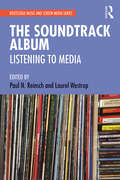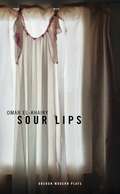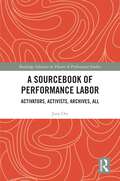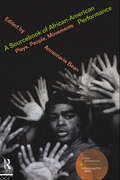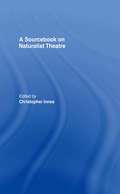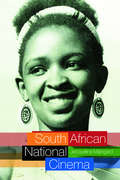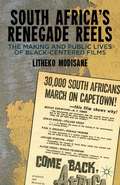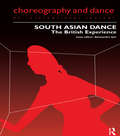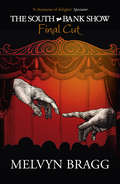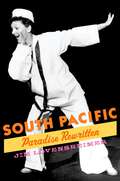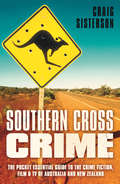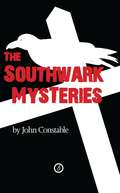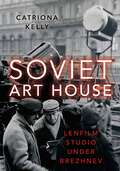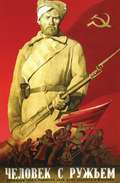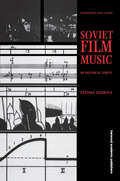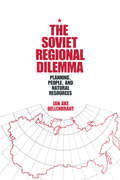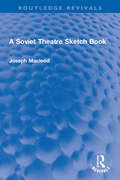- Table View
- List View
The Soundtrack Album: Listening to Media
by Paul Reinsch Laurel WestrupThe Soundtrack Album: Listening to Media offers the first sustained exploration of the soundtrack album as a distinctive form of media. Soundtrack albums have been part of our media and musical landscape for decades, enduring across formats from vinyl and 8-tracks to streaming playlists. This book makes the case that soundtrack albums are more than promotional tools for films, television shows, or video games— they are complex media texts that reward a detailed analysis. The collection’s contributors explore a diverse range of soundtrack albums, from Super Fly to Stranger Things, revealing how these albums change our understanding of the music and film industries and the audio-visual relationships that drive them. An excellent resource for students of Music, Media Studies, and Film/Screen Media courses, The Soundtrack Album offers interdisciplinary perspectives and opens new areas for exploration in music and media studies.
Sour Lips (Oberon Modern Plays)
by Omar El-KhairyI was still living as an Arab Muslim in America. I struggled with coming out to friends and family, and so I decided to come back to Syria. It hasn’t been easy. But we are here, just as we are everywhere.DAMASCUS 18:00 – Amina was walking near Fares Al-Khouri Street when three armed men seized her. According to an eyewitness, Amina was bustled into ared Dacia Logan with a bumper sticker of Basel Assad. The men are assumed to be members of the Ba’ath Partymilitia or one of the security services. Amina’s present location is still unknown. Following the story of Amina Arraf, the blogger known as ‘A Gay Girl In Damascus’, and the events fomented by the media’s coverage of her kidnapping, Sour Lips fuses fantasy and non-fiction to create its own speculative narrative.This play is a fictional account, inspired by both a hoax and its true story. It contains extracts from Tom MacMaster’s weblog, A Gay Girl in Damascus. However, the characters, timelines and incidents have been changed for dramatic purposes. In some cases, fictitious characters and incidents have been further added to the narrative, and the words are those imagined by the author. The play should not be understood as either a biography or factual account.
A Sourcebook of Performance Labor: Activators, Activists, Archives, All (Routledge Advances in Theatre & Performance Studies)
by Joey OrrA Sourcebook of Performance Labor presents the views and experiences of collaborators in other artists’ works. This book reorients well-known works of contemporary performance and social practice around the workers who have shaped, enacted, and supported them. It emerges from perspectives on maintenance, care, affective labor, and the knowledges created and preserved through gesture and intersubjectivity. This compilation of interviews is filled with the voices of collaborators in notable works attributed to established contemporary artists, including Francis Alÿs, Tania Bruguera, Suzanne Lacy, Ernesto Pujol, Asad Raza, Dread Scott, and Tino Sehgal. In the spirit of the artworks under discussion, this book reinvests in the possibilities for art as a collective effort to explore new ways of finding ourselves in others and others in ourselves. The Sourcebook collection is a contribution for further theorizing a largely unaddressed perspective in contemporary art. This collection will be of great interest to students and scholars in performance studies and art history.
A Sourcebook of Performance Labor: Activators, Activists, Archives, All (Routledge Advances in Theatre & Performance Studies)
by Joey OrrA Sourcebook of Performance Labor presents the views and experiences of collaborators in other artists’ works. This book reorients well-known works of contemporary performance and social practice around the workers who have shaped, enacted, and supported them. It emerges from perspectives on maintenance, care, affective labor, and the knowledges created and preserved through gesture and intersubjectivity. This compilation of interviews is filled with the voices of collaborators in notable works attributed to established contemporary artists, including Francis Alÿs, Tania Bruguera, Suzanne Lacy, Ernesto Pujol, Asad Raza, Dread Scott, and Tino Sehgal. In the spirit of the artworks under discussion, this book reinvests in the possibilities for art as a collective effort to explore new ways of finding ourselves in others and others in ourselves. The Sourcebook collection is a contribution for further theorizing a largely unaddressed perspective in contemporary art. This collection will be of great interest to students and scholars in performance studies and art history.
A Sourcebook on African-American Performance: Plays, People, Movements (Worlds of Performance)
by Annemarie BeanA Sourcebook on African-American Performance is the first volume to consider African-American performance between and beyond the Black Arts Movement of the 1960s and the New Black Renaissance of the 1990s.As with all titles in the Worlds of Performance series, the Sourcebook consists of classic texts as well as newly commissioned pieces by notable scholars, writers and performers. It includes the plays 'Sally's Rape' by Robbie McCauley and 'The American Play' by Suzan-Lori Parks, and comes complete with a substantial, historical introduction by Annemarie Bean.Articles, essays, manifestos and interviews included cover topics such as:* theatre on the professional, revolutionary and college stages* concert dance* community activism * step shows* performance art.Contributors include Annemarie Bean, Ed Bullins, Barbara Lewis, John O'Neal, Glenda Dickersun, James V. Hatch, Warren Budine Jr. and Eugene Nesmith.
A Sourcebook on African-American Performance: Plays, People, Movements (Worlds of Performance)
by Annemarie BeanA Sourcebook on African-American Performance is the first volume to consider African-American performance between and beyond the Black Arts Movement of the 1960s and the New Black Renaissance of the 1990s.As with all titles in the Worlds of Performance series, the Sourcebook consists of classic texts as well as newly commissioned pieces by notable scholars, writers and performers. It includes the plays 'Sally's Rape' by Robbie McCauley and 'The American Play' by Suzan-Lori Parks, and comes complete with a substantial, historical introduction by Annemarie Bean.Articles, essays, manifestos and interviews included cover topics such as:* theatre on the professional, revolutionary and college stages* concert dance* community activism * step shows* performance art.Contributors include Annemarie Bean, Ed Bullins, Barbara Lewis, John O'Neal, Glenda Dickersun, James V. Hatch, Warren Budine Jr. and Eugene Nesmith.
A Sourcebook on Naturalist Theatre
by Christopher InnesA Sourcebook on Naturalist Theatre provides essential primary sources which document one of the key movements in modern theatre. Christopher Innes has selected three writers to exemplify the movement, and six plays in particular: * Henrik Ibsen - A Dolls House and Hedda Gabler * Anton Chekhov - The Seagull and The Cherry Orchard * George Bernard Shaw - Mrs Warren's Profession and Heartbreak House. Innes' introduction provides an overview of naturalist theatre. Key themes include: the representation of women, significant contemporary issues and the links between theory, play writing and stage practice. The primary sources explore many aspects of naturalism, giving information on: * the playwrights' intentions when writing plays * contemporary reviews * literary criticism * political and social background * production notes from early performances of the plays.
A Sourcebook on Naturalist Theatre
by Christopher InnesA Sourcebook on Naturalist Theatre provides essential primary sources which document one of the key movements in modern theatre. Christopher Innes has selected three writers to exemplify the movement, and six plays in particular: * Henrik Ibsen - A Dolls House and Hedda Gabler * Anton Chekhov - The Seagull and The Cherry Orchard * George Bernard Shaw - Mrs Warren's Profession and Heartbreak House. Innes' introduction provides an overview of naturalist theatre. Key themes include: the representation of women, significant contemporary issues and the links between theory, play writing and stage practice. The primary sources explore many aspects of naturalism, giving information on: * the playwrights' intentions when writing plays * contemporary reviews * literary criticism * political and social background * production notes from early performances of the plays.
South African National Cinema (National Cinemas)
by Jacqueline MaingardSouth African National Cinema examines how cinema in South Africa represents national identities, particularly with regard to race. This significant and unique contribution establishes interrelationships between South African cinema and key points in South Africa’s history, showing how cinema figures in the making, entrenching and undoing of apartheid. This study spans the twentieth century and beyond through detailed analyses of selected films, beginning with De Voortrekkers (1916) through to Mapantsula (1988) and films produced post apartheid, including Drum (2004), Tsotsi (2005) and Zulu Love Letter (2004). Jacqueline Maingard discusses how cinema reproduced and constructed a white national identity, taking readers through cinema’s role in building white Afrikaner nationalism in the 1930s and 1940s. She then moves to examine film culture and modernity in the development of black audiences from the 1920s to the 1950s, especially in a group of films that includes Jim Comes to Joburg (1949) and Come Back, Africa (1959). Jacqueline Maingard also considers the effects of the apartheid state’s film subsidy system in the 1960s and 1970s and focuses on cinema against apartheid in the 1980s. She reflects upon shifting national cinema policies following the first democratic election in 1994 and how it became possible for the first time to imagine an inclusive national film culture. Illustrated throughout with excellent visual examples, this cinema history will be of value to film scholars and historians, as well as to practitioners in South Africa today.
South African National Cinema (National Cinemas)
by Jacqueline MaingardSouth African National Cinema examines how cinema in South Africa represents national identities, particularly with regard to race. This significant and unique contribution establishes interrelationships between South African cinema and key points in South Africa’s history, showing how cinema figures in the making, entrenching and undoing of apartheid. This study spans the twentieth century and beyond through detailed analyses of selected films, beginning with De Voortrekkers (1916) through to Mapantsula (1988) and films produced post apartheid, including Drum (2004), Tsotsi (2005) and Zulu Love Letter (2004). Jacqueline Maingard discusses how cinema reproduced and constructed a white national identity, taking readers through cinema’s role in building white Afrikaner nationalism in the 1930s and 1940s. She then moves to examine film culture and modernity in the development of black audiences from the 1920s to the 1950s, especially in a group of films that includes Jim Comes to Joburg (1949) and Come Back, Africa (1959). Jacqueline Maingard also considers the effects of the apartheid state’s film subsidy system in the 1960s and 1970s and focuses on cinema against apartheid in the 1980s. She reflects upon shifting national cinema policies following the first democratic election in 1994 and how it became possible for the first time to imagine an inclusive national film culture. Illustrated throughout with excellent visual examples, this cinema history will be of value to film scholars and historians, as well as to practitioners in South Africa today.
South Africa's Renegade Reels: The Making and Public Lives of Black-Centered Films
by L. ModisaneDespite incredible political upheavals and a minimal national history of film production, movies such as Come Back, Africa (1959), uDeliwe (1975), and Fools (1998) have taken on an iconic status within South African culture. In this much-needed study, author Litheko Modisane delves into the public critical engagements around old 'renegade' films and newer ones, revealing instructive details both in the production and the public lives of South African movies oriented around black social experiences. This illuminates the complex nature of cinema in modern public life, enriching established methodologies by expanding the cultural and conceptual boundaries of film as a phenomenon of textual circulation.
South Asian Dance: The British Experience
by Alessandra IyerFirst Published in 1998. Routledge is an imprint of Taylor & Francis, an informa company.
South Asian Dance: The British Experience
by Alessandra IyerFirst Published in 1998. Routledge is an imprint of Taylor & Francis, an informa company.
The South Bank Show: Final Cut
by Melvyn BraggWhat drives a musician to write extraordinary songs? How do writers create their worlds? How does an actor achieve greatness?For over thirty years of The South Bank Show, Melvyn Bragg has interviewed many of the greatest cultural icons of our age. These interviews offer revelatory insights into the lives and work of writers, actors, artists and musicians. In The South Bank Show: Final Cut he has revisited some of these artists and used the interviews as the basis for fuller portraits.The range of artists is remarkable and this book is true to The South Bank Show’s ethos of seeking out the highest quality whatever the art form.Melvyn Bragg’s unique perspective makes this book indispensable for anyone interested in the work and lives of some of the best artists of our time.
South Pacific: Paradise Rewritten (Broadway Legacies)
by Jim LovensheimerRodgers and Hammerstein's Tony and Pulitzer Prize-winning musical "South Pacific" has remained a mainstay of the American musical theater since it opened in 1949, and its powerful message about racial intolerance continues to resonate with twenty-first century audiences. Drawing on extensive research in the Rodgers and the Hammerstein papers, including Hammerstein's personal notes on James A. Michener's Tales of the South Pacific, Jim Lovensheimer offers a fascinating reading of "South Pacific" that explores the show's complex messages and demonstrates how the presentation of those messages changed throughout the creative process. Indeed, the author shows how Rodgers and especially Hammerstein continually refined and softened the theme of racial intolerance until it was more acceptable to mainstream Broadway audiences. Likewise, Lovensheimer describes the treatment of gender and colonialism in the musical, tracing how it both reflected and challenged early Cold War Era American norms. The book also offers valuable background to the writing of "South Pacific," exploring the earlier careers of both Rodgers and Hammerstein, showing how they frequently explored serious social issues in their other works, and discussing their involvement in the political movements of their day, such as Hammerstein's founding membership in the Hollywood Anti-Nazi League. Finally, the book features many wonderful appendices, including two that compare the original draft and final form of the classic songs "I'm Gonna Wash That Man Right Out-a My Hair" and "I'm In Love With a Wonderful Guy." Thoroughly researched and compellingly written, this superb book offers a rich, intriguing portrait of a Broadway masterpiece and the era in which it was created.
South Pacific: Paradise Rewritten (Broadway Legacies)
by Jim LovensheimerRodgers and Hammerstein's Tony and Pulitzer Prize-winning musical "South Pacific" has remained a mainstay of the American musical theater since it opened in 1949, and its powerful message about racial intolerance continues to resonate with twenty-first century audiences. Drawing on extensive research in the Rodgers and the Hammerstein papers, including Hammerstein's personal notes on James A. Michener's Tales of the South Pacific, Jim Lovensheimer offers a fascinating reading of "South Pacific" that explores the show's complex messages and demonstrates how the presentation of those messages changed throughout the creative process. Indeed, the author shows how Rodgers and especially Hammerstein continually refined and softened the theme of racial intolerance until it was more acceptable to mainstream Broadway audiences. Likewise, Lovensheimer describes the treatment of gender and colonialism in the musical, tracing how it both reflected and challenged early Cold War Era American norms. The book also offers valuable background to the writing of "South Pacific," exploring the earlier careers of both Rodgers and Hammerstein, showing how they frequently explored serious social issues in their other works, and discussing their involvement in the political movements of their day, such as Hammerstein's founding membership in the Hollywood Anti-Nazi League. Finally, the book features many wonderful appendices, including two that compare the original draft and final form of the classic songs "I'm Gonna Wash That Man Right Out-a My Hair" and "I'm In Love With a Wonderful Guy." Thoroughly researched and compellingly written, this superb book offers a rich, intriguing portrait of a Broadway masterpiece and the era in which it was created.
Southern Cross Crime: The Pocket Essential Guide to the Crime Fiction, Film and TV of Australia and New Zealand
by Craig SistersonAustralian and New Zealand crime and thriller writing - collectively referred to as Southern Cross Crime - is booming globally, with antipodean authors regularly featuring on awards and bestseller lists, such as Eleanor Catton's Booker Prize winning The Luminaries and Jane Harper's big commercial hit, The Dry, winner of the CWA Gold Dagger Award.Hailing from two sparsely populated nations on the far edge of the former Empire - neighbours that are siblings in spirit, vastly different in landscape - Australian and New Zealand crime writers offer readers a blend of exotic and familiar, seasoned by distinctive senses of place, outlook, and humour, and roots that trace to the earliest days of our genre.Southern Cross Crime is the first comprehensive guide to modern crime writing from "Down Under". From coastal cities to the outback, leading critic Craig Sisterson showcases key titles from over 250 storytellers, plus screen dramas ranging from Mystery Road to Top of the Lake. Fascinating insights are added through in-depth interviews with some of the prime suspects who paved the way or instigated the global boom, including Michael Robotham, Paul Cleave, Emma Viskic, Paul Thomas, Candice Fox, and Garry Disher.
The Southwark Mysteries
by John Constable“I was born a Goose of Southwark by the Grace of Mary Overie, Whose Bishop gives me licence to sin within The Liberty. In Bankside stews and taverns you can hear me honk right daintily, As I unlock the hidden door, unveil the Secret History.” The Liberty of the Clink dates back to 1107 when the Bishop of Winchester was granted a stretch of the Southwark Bankside, which lay outside the law of the City of London. Here, the Bishop controlled the brothels, or stews. The whores of The Liberty were known as Winchester Geese. The Vision Books of The Southwark Mysteries were first revealed by The Goose to John Crow, trickster-familiar of the poet and playwright John Constable, on 23rd November 1996. In these apocalyptic verses, John Crow encounters The Goose at Crossbones, the whores’ graveyard unearthed during work on the Jubilee Line Extension. She initiates him into a secret history spanning 2,000 years – a vision of the Spirit in the flesh, the Sacred in the profane, Eternity in time. This vision informs The Mystery Plays, a contemporary “Southwark Cycle” rooted in the medieval mysteries, retelling sacred stories in the earthy language and context of our own time and place. This epic drama was first performed in Shakespeare’s Globe and Southwark Cathedral on Easter Sunday, 23rd April 2000. A new production was presented in Southwark Cathedral in 2010. The third part of the work is a Glossolalia of local history and esoteric lore to be read in conjunction with the poems and plays." "Past and present, sacred and profane jostle and collide in a glorious tumult in this anarchic drama... it’s couched in verse that is muscular, ribald, and often dazzlingly rich... It’s sprawling and unashamedly ragged in execution, but it’s irrepressibly vital: a joyous, gutsy celebration of life, love, faith and forgiveness. " - Sam Marlowe, The Times
Soviet Art House: Lenfilm Studio under Brezhnev
by Catriona KellyIts unique ability to sway the masses has led many observers to consider cinema the artform with the greatest political force. The images it produces can bolster leaders or contribute to their undoing. Soviet filmmakers often had to face great obstacles as they struggled to make art in an authoritarian society that put them not only under ideological pressure but also imposed rigid economic constraints on the industry. But while the Brezhnev era of Soviet filmmaking is often depicted as a period of great repression, Soviet Art House reveals that the films made at the prestigious Lenfilm studio in this period were far more imaginative than is usually suspected. In this pioneering study of a Soviet film studio, author Catriona Kelly delves into previously unpublished archival documents and interviews, memoirs, and the films themselves to illuminate the ideological, economic, and aesthetic dimensions of filmmaking in the Brezhnev era. She argues that especially the young filmmakers who joined the studio after its restructuring in 1961 revitalized its output and helped establish Leningrad as a leading center of oppositional art. This unique insight into Soviet film production shows not only the inner workings of Soviet institutions before the system collapsed but also traces how filmmakers tirelessly dodged and negotiated contradictory demands to create sophisticated and highly original movies.
Soviet Cinema: Politics and Persuasion Under Stalin (KINO - The Russian and Soviet Cinema)
by Jamie MillerWhen the Bolsheviks seized power in the Soviet Union during 1917, they were suffering from a substantial political legitimacy deficit. Uneasy political foundations meant that they were always on the defensive and cinema became a key part of the strategy to protect the existence of the USSR. This welcome book shows how one of film's central functions was as an important means of convincing the masses that the regime was legitimate and a bearer of historical truth.Based on extensive research in archives and primary sources, the book examines the interaction between politics and the Soviet cinema industry during the period between Stalin's rise to power and the beginning of the Great Patriotic War. This was the era when the Bolsheviks were trying to develop a 'cinema for the millions', which sought to engage Soviet citizens politically by carefully blending entertainment with the communist message.Jamie Miller investigates how political and administrative decision-making, censorship, thematic planning and purges were shaped by the Bolsheviks' defensive outlook, which in turn had a largely negative impact on the production process. He examines the role of film unions and societies, compares the development of two different studios and looks at the education system for cinema personnel. He also analyses key films of the period, including the classic musical Circus, the class enemy drama The Party Card and the political epic The Great Citizen.
Soviet Film Music (Contemporary Music Studies)
by Tatiana EgorovaFirst Published in 1998. Routledge is an imprint of Taylor & Francis, an informa company.
Soviet Film Music (Contemporary Music Studies)
by Tatiana EgorovaFirst Published in 1998. Routledge is an imprint of Taylor & Francis, an informa company.
The Soviet Regional Dilemma
by Jan Ake DellenbrantIncorporating an oral history approach, this history of radio covers the impact of the arrival of television, the rise of transistor radios, the popularity of rock n' roll, FM stereo stations, underground radio of the sixties, talk radio, public radio, and how technology will affect its future.
The Soviet Regional Dilemma
by Jan Ake DellenbrantIncorporating an oral history approach, this history of radio covers the impact of the arrival of television, the rise of transistor radios, the popularity of rock n' roll, FM stereo stations, underground radio of the sixties, talk radio, public radio, and how technology will affect its future.
A Soviet Theatre Sketch Book (Routledge Revivals)
by Joseph MacleodFirst Published in 1951, A Soviet Theatre Sketch Book presents Joseph Macleod’s take on Russian Theatre in a semi-fictional way to show the effect of the productions upon different audiences. By using his pen as an artist uses his pencil, he gives, for the first time, an account of theatre audiences as composed of individual human beings and is able to paint the scenes vividly without neglecting the technical methods of the Soviet stage. By supple use of the sketch- book form, theatres, theatre-schools, actors, and actresses including some no longer appearing are painted into an all-over view of Russian and Ukrainian post-war life. In this book the author writes less immediately about the Soviet Union and does not depend on topicality or stop press news. Joseph Macleod and his wife visited the Soviet Union as the guests of the Russian and Ukrainian Societies for Cultural Relations with Foreign Countries. This book will be of interest to scholars and researchers of theatre, history of theatre, and performance studies.
